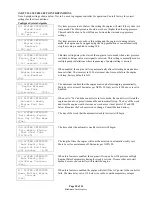
Page 7 of 34
File Name:
Doc#586p.docx
duration. The
"Failed to Start"
light should come on and the alarm horn should sound. Status indicator light for
Terminal #1 should come on as soon as the
"Test"
push button is pressed and the pressure drops below the low set
point. Indicator lights for terminals 9 and 10 should come on alternately to indicate cranking cycle. (See above)
3.
Press the
"Stop"
push button to stop the engine and properly reconnect all leads.
NOTE
:
In order to prevent discharging the starting batteries, this same test can be made without actually
cranking the engine by disconnecting the starter cable and observing the action of the starter contactors
and/or status indicator lights for terminals 9 and 10.
c.
CHECKING STARTING MOTOR RELEASE
1.
Press the “
Test
” mode button. Engine should start promptly and starting motor should release at approximately 1/3 of
engine speed. Status indicator light for terminal #2 should come on to indicate speed switch has operated to disconnect
cranking and the Engine Running LED should illuminate.
NOTE: A convenient method of determining the exact instant the starter releases is to connect a battery test light or
voltmeter across the starter terminals and observe when power is disconnected.
2.
Press the “
Stop
” push button to stop the engine.
d.
OIL PRESSURE FAILURE TEST:
1.
Press the
"Test"
mode button to start engine. When the engine is starting and oil pressure is not yet up to full pressure,
the
"Engine Low Oil Pressure"
light will illuminate, but the horn will not sound. When pressure builds up, and the
switch opens, the light will go out. This feature provides indication that the oil pressure switch contacts are operating
in a normal manner.
Note: On Electronic Engines with electronic oil pressure sensors, the oil pressure light may not illuminate while the
engine is cranking. The low oil pressure test should be performed on these engines with the engine running as described
below.
2.
After the engine is running, connect a temporary jumper between terminal #4 and terminal #11.
3.
Both the
"Engine Low Oil Pressure"
light and status indicator light for terminal #4 should come on immediately.
Wait approximately seven (7) seconds. Alarm horn should sound.
4.
Press the
"Stop"
push button to stop the engine and remove jumper between terminal #4 and terminal #11.
5.
Wait at least 30 seconds for elements to reset before making any further tests.
e.
WATER TEMPERATURE FAILURE TEST:
1.
Press the
"Test"
push button to start engine.
2.
Jumper contacts on water temperature switch on engine.
3.
Alarm horn sounds and the
"High Water Temperature"
light on controller will illuminate after approximately 7
seconds. Status indicator light for terminal #5 should come on with
"High Water Temperature”
light.
4.
Press the
"Stop"
push button to stop the engine and remove jumper on water switch.
f.
OVERSPEED FAILURE TEST:
1.
Press the
"Test" mode
button to start engine.
2.
Momentarily short the contacts on the engine speed switch, or connect a temporary jumper between terminal #3 and #6
on the controller.
3.
The alarm horn sounds and the
"Engine Overspeed"
light will illuminate immediately. Engine comes to a stop.
Status indicator lights for terminals #3 and #12 should come on with the
"Engine Overspeed"
light.
4.
Remove the jumper from terminals #3 and #6 then turn the selector switch to the
Off
position. Press the
"Reset"
button to reset the
“Overspeed”
alarm. Turn the selector switch back to the
Auto
position.
g.
CONTACTOR COIL FAILURE ALARM TEST:
1.
While the controller is in the
"Auto"
mode disconnect the field wire from terminal 9. Within a few seconds the
"Contactor Coil Failure”
lamp should illuminate and the alarm horn should sound. Reconnect the field wire to
terminal 9. The
"Contactor Coil Failure”
lamp should go out and the alarm horn should silence. Repeat for terminal
10.






















